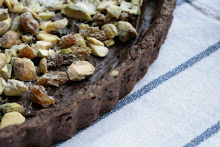Before I gave up, I had to finish this business, baking scones. The first time after two scones-disasters, I finally got nice, light, buttery, flaky scones. Thanks Epicurious for publishing this recipe (it was first published in Gourmet magazine , March 1990).
Ingredients
1/2 C of heavy cream plus additional for brushing the scones (I use egg+1tbsp of milk for brushing)
1 large egg
1 tsp vanilla extract
3 tbsp of sugar plus additional for sprinkling the scone
2 1/4 C of cake flour
1/2 tsp of salt
1 tbsp (or 3 tsp) of double acting baking powder
1/2 tsp of baking soda.
3/4 stick (6 tablespoons or 90 g) of cold unsalted butter, chopped into tiny bits.
1/2 C of dried currants (I used dark raisins)
In a bowl, whisk together 1/2 C of cream, egg , vanilla and 3 tablespoon of sugar until they combine well. I warmed up cream in microwave so that sugar dissolved easier. In another bowl sift all dry ingredients. I sifted twice so that wet ingredients can soak in quicker.
Now the key procedure, working with butter. I don't have food processor. And I cannot work with my bare hands as they are too warm to smash the butter directly into flour. The bottom line we want is coarse crumbs of flour+butter with the size of small tiny peas. My method is to chop up butter into little pieces, as if you are chopping onion for stir fry (some people use cheese grater, but butter must be freezing cold enough to grate) . No surprise, butter will stick to blade and chopping board, so sprinkle sifted flour, set aside in the bowl, would be a good idea. Once chopped, my butter cubes are just as small as 2 x 2 millimetres (oh yeah, they were that small). Feel free to sprinkle more flour while chopping as these will be all scooped back to the bowl. Once done , in the bowl, use pastry blade to cut in butter and flour mixture to coarse crumbs. This process should be quick as the butter cubes are very very tiny and they incorporate into the flour in shorter time. Be careful not to let butter metl, especially if your kitchen temperature is warmer than 25 C . Luckily, my kitchen was freezing cold, 12 C (imagine next week is Christmas !).
Warm up the oven to 200 C. Put the tray in the middle of the rack, no need to grease the tray.
With the fork, stir wet ingredients into the dry, slowly mix in. Don't over stir. How ? pause every 3-4 strokes and let the wets soak in. You'll see that once you pause, flour absorbs humidity around them and becomes lumbs. Continue stiromg, just until combine. Add raisins or other dried fruits of you choice. Some part of the dough will look a bit sandy or dry, that is okay.

On a lightly flour surface , knead the flour for 30 second , approximately 20 strokes, not more than that. I am a gluten nerd, I would do anything to prevent gluten formation as I don't think anyone likes chewy scones. (right ? right?)
Pat down the dough, roll into ½ inch thick. Make sure you roll it evenly; otherwise, the scone will be tilted when baked in the oven. Cut with cookie cutter, set aside. I used the 1.5 inch diameter cutter, yielded 9 scones.
On pre-heated tray, put scones next to each other, don’t leave spaces. Putting them shoulder-to shoulder will help them rise better (crowd them so they have no choice but to sit straight!) Some website suggests to thumb-press on top of scones to prevent domed structure. I didn’t do that, I forgot.
You can brush with cream as advises in the recipe. I brushed with egg, lightly beaten with 1 tbsp of milk. Be careful not to brush on the side as it prevents the edge to rise. Bake for 15-18 minutes or until brown.
Got Tea?
On pre-heated tray, put scones next to each other, don’t leave spaces. Putting them shoulder-to shoulder will help them rise better (crowd them so they have no choice but to sit straight!) Some website suggests to thumb-press on top of scones to prevent domed structure. I didn’t do that, I forgot.
You can brush with cream as advises in the recipe. I brushed with egg, lightly beaten with 1 tbsp of milk. Be careful not to brush on the side as it prevents the edge to rise. Bake for 15-18 minutes or until brown.
Got Tea?






No comments:
Post a Comment